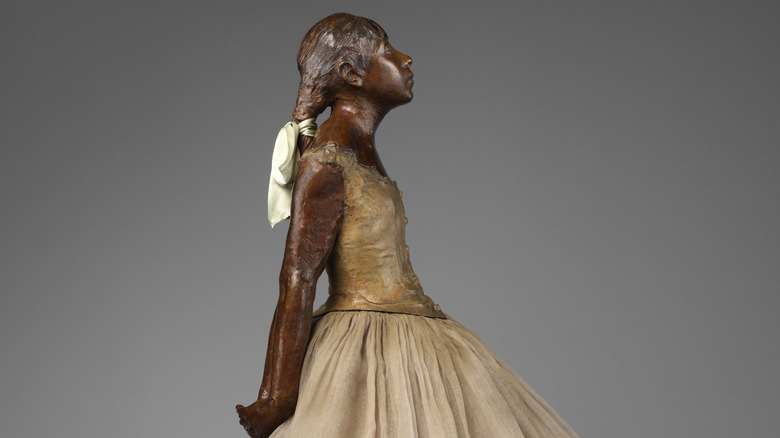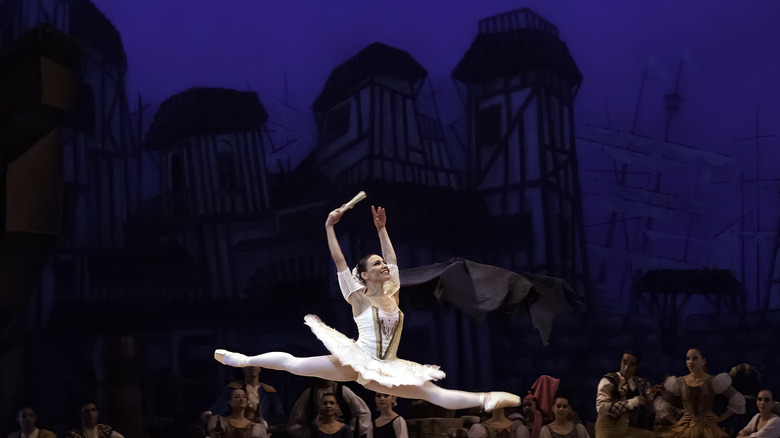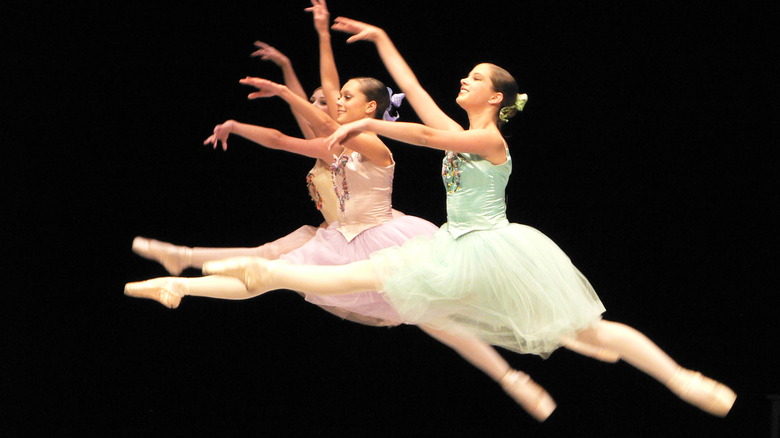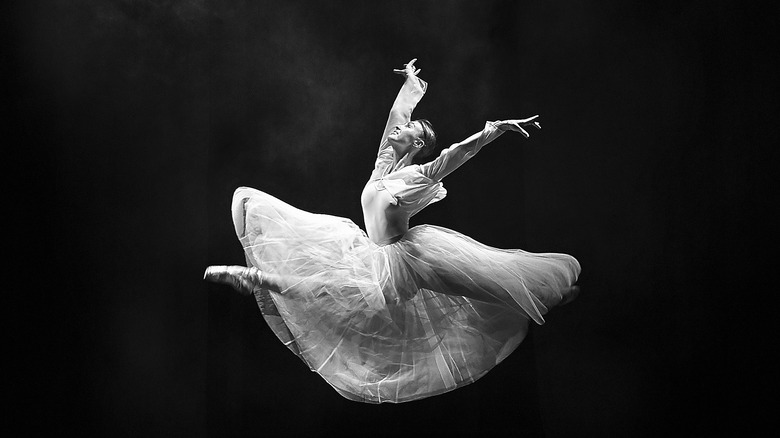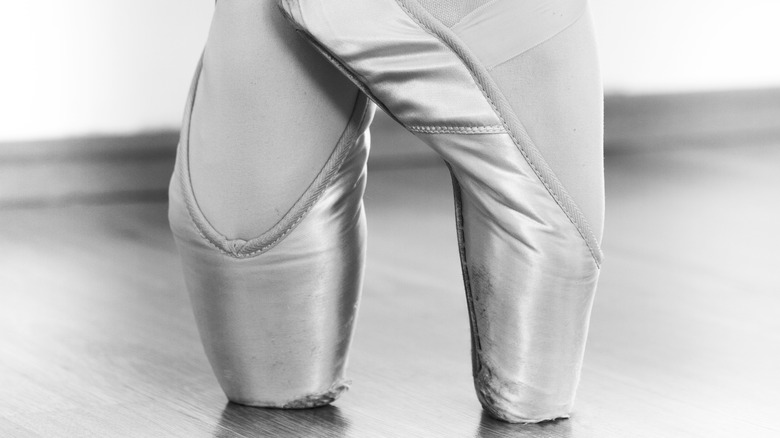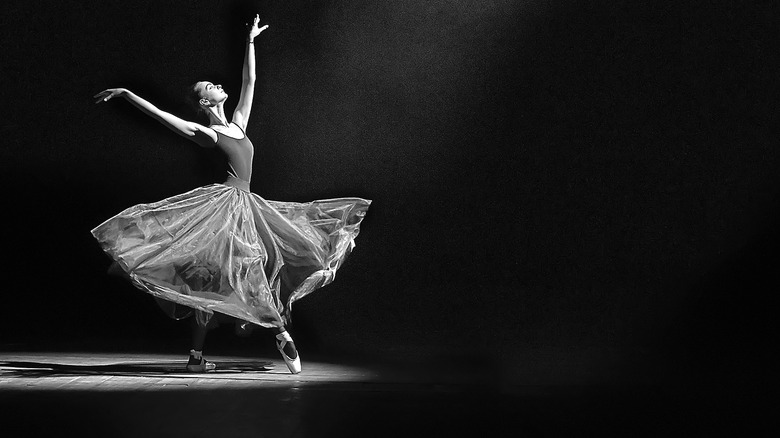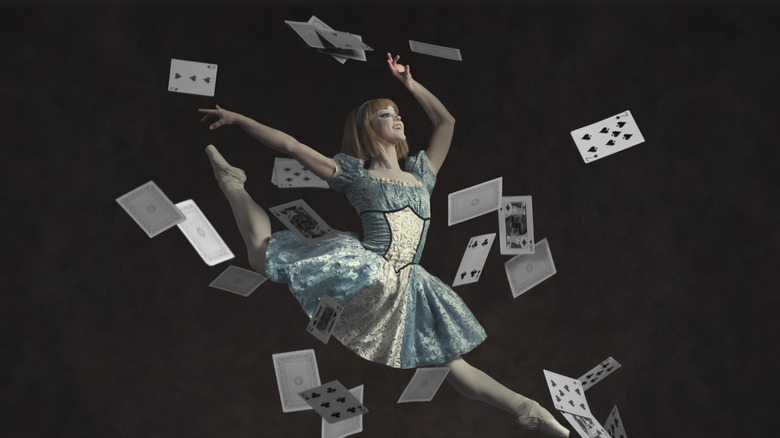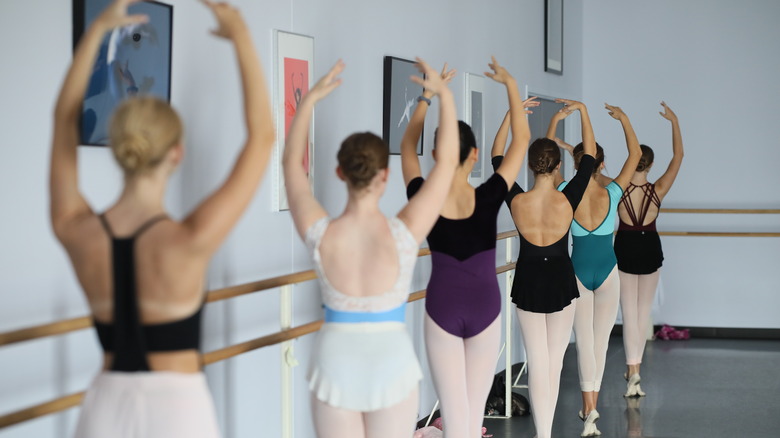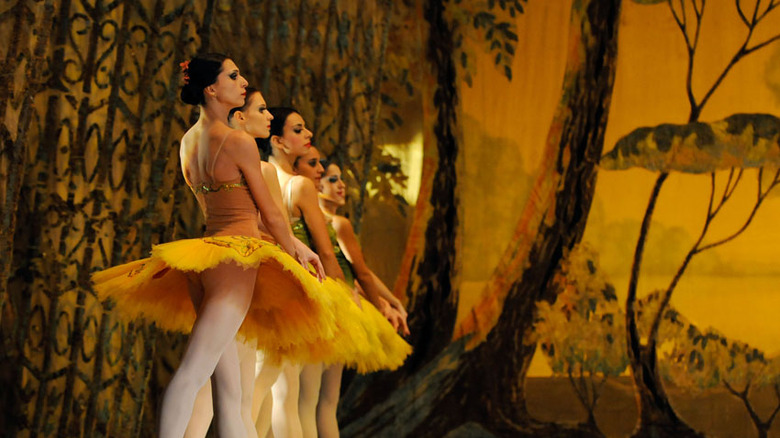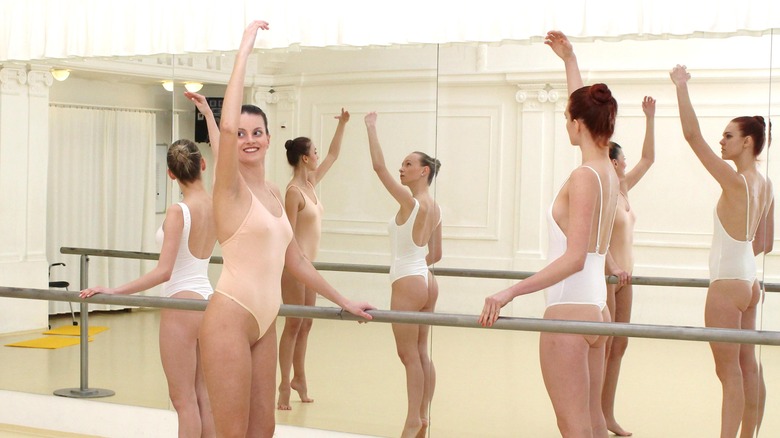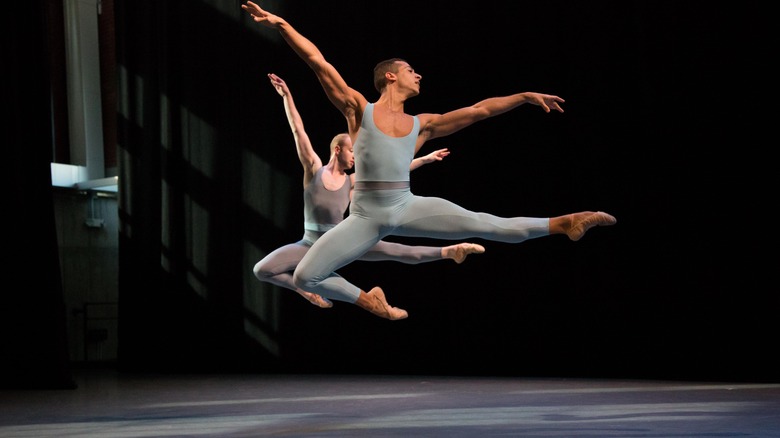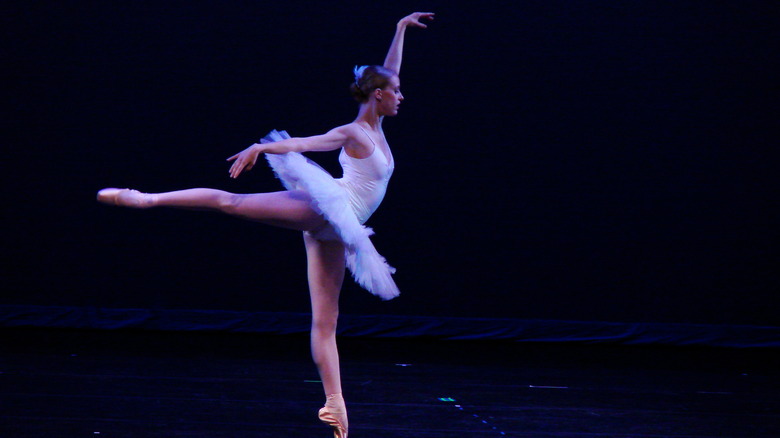Dark Secrets Of Ballet Revealed
Ballet is a beautiful, though tremendously painstaking, art. The goal is for everything to look effortless, as though it isn't costing the dancer anything at all, even though this is, of course, ridiculous. Many aspects of dance are physically difficult. Every jump, every turn, every bend that goes wrong can also break something in the body — not to mention spoil the image of strong dancers, acting out a story that is beyond themselves.
Just as French artist Edgar Degas conveyed in his 1881 sculpture "Little Dancer of Fourteen Years", according to the National Gallery of Art, dancers are put through their paces every time they step onto the floor. Dance is hours and weeks and years of hard work, and the life of a ballerina definitely has its downsides. To make it as a professional is incredibly difficult, since so many dancers are hoping for a limited number of spots. Injuries are common, and dance is not a full-time career.
On the other hand, shows like "Tiny Pretty Things" would have you believe that even murder wouldn't be out of the ordinary. Things aren't quite that bad, though ballet does need rich sponsors to keep running. Therefore, let's discuss some of the dark secrets of the ballet world.
Instructors can be overly strict
Dance involves a lot of physical correcting and placement of the body. As a result, some teachers can focus too much on losing weight or not having the right body for dance, writes Romper. Noelle Rose Andressen, the director at Rubens Rouges Dance, says that she still remembers seeing her teacher's face "wrinkle up with scorn" (via Romper).
Overly harsh corrections can also injure the dancer without anyone realizing it, and in 2017, a video circulated of a gymnastics coach was fired after forcing a 13-year-old gymnast further into the splits while she cried from the pain of the action (via WTSP). "Being forced into anything when you're not ready, physically or emotionally, is traumatizing," explains dance therapist Erica Hornthal, of Chicago Dance Therapy (via Romper). Even if the dancer isn't injured from being pushed into a pose, they can absolutely realize that their instructor has more power over them and can do what they want.
Ballet is a popular Russian art form, and the Vaganova Ballet Academy in St. Petersburg teaches students how to dance properly over eight years. Dance Teacher spoke to several Russian ballet teachers when they taught in the U.S., learning which of their methods had changed and which had stayed the same. The Vaganova Academy only accepts students with the right body for ballet, and learning how to teach everyone individually, including those students who wouldn't go on to be professional dancers, was something all the teachers had to figure out.
Injuries to the hips, knees, and arms are common
Since dance is such a physical art, dancers can be injured easily. Performing repetitive movements for hours and days on end can lead to overuse injuries in the hips, ankles, and knees. Male dancers, who need to be able to lift females in specific choreography, can develop arm and shoulder problems, writes Romper.
Injuries start young, particularly with dancers who take several classes and rehearsals throughout the week. For example, young dancers who are aiming to be professional usually receive their first ankle sprains by age 13. Dr. Derek Ochiai, who works at the Virginia Sportsmedicine Institute, writes Romper, has seen several 16-year-old dancers with hip injuries requiring surgery.
Turn out is one of the most important aspects of dance, and as a result, hip impingement is common, since it develops, in part, due to the difference dancers have in external and internal rotation, according to Neurotour. Plus, some professional dancers may perform up to eight shows a week. Irritations might not be noticed until they start hurting; snapping hip starts as a snapping sound while performing battements, which is only irritating until it becomes painful. Dancers may also partly cause their own problems by dancing through their injuries. Performances are grueling enough without taking time off, and no one wants to lose a part due to dropping out with injuries. Ochiai says, "I've had several dancers tell me ballet is their life, and they're 14 years old," (via Romper).
Disordered eating can be common
Nearly all dancers develop some form of dysfunctional eating, even if it isn't a full-blown eating disorder. Weight gain and loss as triggers for the need to be perfect are woven into the fabric of dance, writes Pointe Magazine. Ballet is such a specific art that dancers become self-disciplined to compensate for what they perceive to be their own failures. Eventually, that mindset to be perfect can become an obsession. When combined with an eating disorder — or even just disordered eating — the consequences can be disastrous.
Disordered eating, writes Dance Magazine, is not diagnosable as a disorder because it's just a series of behaviors, which include restricting types of food, having specific rules around food, and over-exercising, among others. Women in athletics with an aesthetic element — such as gymnastics, dance, and ice skating — are the most vulnerable group for developing a form of disordered eating (via Dance Magazine).
A review and analysis of dancers and eating disorders published in the European Eating Disorders Review concluded that dancers were at a higher risk for experiencing anorexia nervosa and eating disorders that weren't categorized, which could include disordered eating. The study also concluded that dancers weren't at a higher risk for bulimia, however.
If you are struggling with an eating disorder, or know someone who is, help is available. Visit the National Eating Disorders Association website or contact NEDA's Live Helpline at 1-800-931-2237. You can also receive 24/7 Crisis Support via text (send NEDA to 741-741).
Pointe shoes ruin feet
Advanced dancers who dance on pointe ruin their feet over time. Pointe shoes force all the dancer's weight to be on their toes and feet. This can lead to ankle, toe, heel, and bone injuries, which can be permanent if not treated.
Humans were not made to balance all their weight on their toes for hours at a time. Forcing that much pressure on a relatively small part of the body can lead to plenty of problems in the future. Healthline writes that common injuries include bunions, dancer's heel, and stress fractures. Several injuries, including bunions, happen due to pressure on the big toe joint. The toes are pressed together in the toe box of the pointe shoe, which can cause bunions, ingrown nails, and broken nails.
Lower Extremity Review Magazine writes that moving quickly from being on pointe to a demi-plie position, with the feet down and the knees bent, puts tremendous pressure on the ankles and feet due to having to bear the entirety of the dancer's weight in both positions. In regards to injuries, it is also difficult to put any medical supports on or in pointe shoes due to how closely they mold to the dancer's foot. Dancer's bare feet don't look pretty after plenty of work on pointe. Bunions, black nails, and broken skin are all prices to pay for having the strength to work on pointe.
It's easy for dancers to compare themselves unfavorably to others
Since dancers are constantly looking in the mirror at themselves and one another, it's easy to unfavorably compare their performances and looks. Thanks to being judged on how well a dancer performed physically, their self-worth can end up being tied to their ballet ability, writes Romper.
The mirror is both a trap and a salvation, as it helps dancers see how they are physically performing, but also allows them to look at others and begin comparing performances. Smart, strong dancers, according to Romper, have the ability to step outside of themselves while dancing and treat their performances as if they are playing a character. Other dancers may have the misfortune to fall completely into their art without hope of finding themselves again.
Dance Spirit reminds dancers that everyone is unique and brings their own gifts to the table in regards to dance. Some dancers might simply need more time to develop in order to perform a particular move or to dance on pointe, for example. Dancers can also goad classmates into self-criticism; teachers may unwittingly do the same.
Few have the 'right body' for ballet
Ballet demands such precision that few are born with the so-called "perfect" body for the art. This can lead to instructors repeatedly telling dancers they are more suited for something else, or informing them year after year that they won't make it as a ballet dancer.
Extreme thinness still pervades as an ideal for female dancers, writes Dance Magazine. Standards for male dancers have always been broader than those for female dancers, and are getting broader still, while standards for women seem to be getting narrower. While a 6-foot, muscular man is allowed to be broad, it is thought that women need to be small in order to be lifted, which is simply not true. It's important for women to have muscle mass to help lift themselves up as well.
According to Dance Magazine, companies are searching for talent regardless of whether the dancer is a little too tall or doesn't have perfect feet. On the other hand, some companies have height requirements for which dancers they will accept. The standards are changing, but change is slow to come.
Ballet dancers don't make much money
Ballet companies depend on the patronage of sponsors, donations, and gifts, and they often struggle for money. As a result, dancers work on contract and aren't paid well. They dance because it's their passion, not for the money, writes Cosmopolitan. Elice McKinley, a dancer with the Carolina Ballet, notes that she was on food stamps when she first started there; she was also paid at one level below what she should have been, due to budget constraints. Rich sponsors are a big part of why ballet companies are able to continue running, writes HuffPost.
Most professional dancers make less than $25,000 a year, according to HuffPost, and many have side jobs, either teaching or looking for guest spots with other companies, in addition to their work with their company (via Cosmopolitan). A survey in Washington, D.C., reported dancers have an average of four side jobs.
A few American companies offer regular salaried work throughout the whole year, but most dancers end up taking unemployment in the summer months (via HuffPost).HuffPost also raises the possibility that dancers are infantilized and not considered as serious artists, making it easier to rationalize paying them badly. After all, working multiple jobs as a starving artist is a rite of passage, right?
Dancers strive for perfection and their mental health suffers
Dance schools can be toxic environments that normalize emotional and physical abuse. Dancers thus strive for perfection while mostly receiving negative corrections. Teachers who physically overcorrect are also the type to focus on the negatives.
Dancers fail every day, usually multiple times. Kathleen McGuire danced as a teenager, but was never confident. As a result, the small everyday failures began to chip away at her, leading to depression that caused her to leave the dance world (via Dance Magazine). The lack of mental health treatment is, she believes, a severe failure of the dance community to its dancers.
Psychology Today writes that in dance, there are no excuses accepted other than not making enough effort, and as a result, perfectionism can be rampant. People have suggested the dance world is toxic due to perfectionism, and though improvements are in progess, everything is slow to change in practice.
If you or someone you know is struggling with mental health, please contact the Crisis Text Line by texting HOME to 741741, call the National Alliance on Mental Illness helpline at 1-800-950-NAMI (6264), or visit the National Institute of Mental Health website.
Ballet is a classist and elitist art form
Since lower-income families often cannot afford to either go to the theater or pay for lessons and expensive shoes, professional ballet is often restricted to families with money. (Community centers do try to shore up the gap by helping disadvantaged students to dance, though, writes The Boar.)
European ballet in particular lauds white ballerinas. According to NBC News, Black dancer Chloe Lopes Gomes called out the dance world for its racism in early 2021, explaining she had been mocked for her skin color and offered white skin makeup for performances, despite her German ballet company, Staatsballett, having dropped that requirement three years earlier. Several dancers of color in America spoke out in solidarity with Gomes. She said, via NBC News, "Asking not only a Black person but a ballerina to color their skin to look whiter, I don't think it's right — I felt very humiliated and very alone."
Those who patronize the ballet follow a similar trend. The Atlanta Ballet ran a gala in 2004 where the dancers were auctioned off to sponsors for the year, according to the New York Times. The practice of allowing individuals to sponsor specific dancers is becoming increasingly common. Due to the practice, sponsors might think they have a say over who receives certain roles, although that should be at the discretion of artistic management. Also, what exactly is being purchased here, so that ballet companies can continue to exist and operate?
Boys are bullied for dancing
Ballet is seen as a "girly" activity, and boys aren't looked on favorably for dancing. In August 2020, Good Morning America host Lara Spencer made distasteful comments regarding Britain's Prince George and his ballet classes, and the dance world erupted in uproar, writes Dance Informa, seeing her comments as bullying. Though Spencer apologized, notes the Washington Post, some felt it was too little too late. Former New York City ballet principal Philip Neal, who received solace from dance after experiencing bullying, said, "It's ridiculing the curriculum as well as making fun of boys who dance."
Dancers also made note of all the good things dance can give young people, such as community, love, and salvation. Unfortunately, bullying and forcing children to act within their assigned gender roles are global problems that affect more than just the dance world, notes Dance Informa. According to LA Dance Chronicle, studies show that well over 90% of boys who dance have been subjected to harassment and bullying.
Dance Magazine feels that teachers should work to stop bullying wherever they can. There are also actions schools and community centers can take to normalize dance in the eyes of boys, who might find it interesting once they know more about it. In regards to bullying, dancer and choreographer Chris Bell says, "A lot of the kids who bully want some kind of essential quality ... They want the freedom that you already have to do what you love."
Dancers are particularly vulnerable to sexual abuse
Authority and following directions means a lot to ballet dancers, and as a result, grooming and sexual abuse have been making the headlines recently. According to Pointe Magazine, grooming, where a person uses various behaviors to convince someone to do something for their benefit, has the potential to be rampant in the dance community because of how much it relies on dancers being compliant in the face of instructions from those higher up the hierarchy.
Charges were filed in 2021 against a former Boston Ballet dancer, Dusty Button, and her husband Mitchell Taylor Button, writes the Boston Globe. They have been accused of sexual abuse by five different dancers across multiple states. Dancer Sage Humphries says the couple "manipulated and brutalized" her. Two dancers were minors at the time of the alleged abuse, with Gina Mendichino relating that she was 13 to Taylor Button's 25 when he taught her at a Florida studio (via Boston Globe). One dancer who remained anonymous referred specifically to grooming when she related that Button and her husband had promised to make sure her career went well if she followed their instructions.
This case is ongoing, and it will hopefully shed light on the troubling practice in the dance community. Urbanity Dance, in Boston, was unaware of the case, but was supportive of the dancers, writing via the Boston Globe: "We stand in solidarity with this young woman and applaud her bravery in coming forward to share her truth."
If you or anyone you know has been a victim of sexual assault, help is available. Visit the Rape, Abuse & Incest National Network website or contact RAINN's National Helpline at 1-800-656-HOPE (4673).
